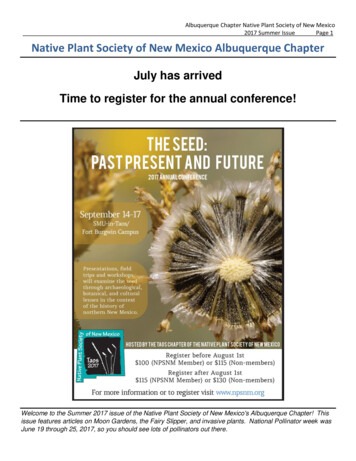
Transcription
Albuquerque Chapter Native Plant Society of New Mexico2017 Summer IssuePage 1Native Plant Society of New Mexico Albuquerque ChapterJuly has arrivedTime to register for the annual conference!Welcome to the Summer 2017 issue of the Native Plant Society of New Mexico's Albuquerque Chapter! Thisissue features articles on Moon Gardens, the Fairy Slipper, and invasive plants. National Pollinator week wasJune 19 through 25, 2017, so you should see lots of pollinators out there.
Albuquerque Chapter Native Plant Society of New Mexico2017 Summer IssuePage 2A mystery plant:What is it?Photo George O. MillerAnswer and description on back page.Keep reading for a photo hint.The Albuquerque Chapter participated in thefollowing events this spring:June 2017President’s MessageGeorge MillerApril 21 Earth Day at Sandia High SchoolApril 22 Bosque del Apache Desert Arboretum StrollThe Albuquerque Chapter has had a busy spring withfield trips, tabling events, and excellent monthlyprograms and field trips. We talked with hundreds ofpeople about the importance of native plants at threetables for Earth Day in April and one at the BioparkNational Garden Day in May. For National PollinatorWeek in June we hosted a pollinator garden tour andtable at the Bee City Pollinator Festival at the OpenSpace Center. Plus we presented backyard pollinatorhabitat programs at Herbfest at the Rio Grande NatureCenter, and at a garden club and the NPS chapter inTaos. Thanks to all the volunteers who helped usspread the conservation message.April 23 Earth Day at LaMontanita Co-op, Nob HillMay 12 National Garden Day the ABQ BioParkMay 13 & 14 Herbfest at the Nature CenterJune 18 Bee City USA Pollinator Celebration at theAlbuquerque Open Space Visitor CenterJudging by the interest in our booths, there is muchenthusiasm for Native Plants. A big thanks to all thevolunteers who helped staff these events.Thank you! Bettie HinesSummer may be blazing, but we have three field tripsscheduled for both July and August – cross your fingers for a good (and cooler) monsoon season! And don’tforget the state meeting in Taos September 14-16. The theme is “Seeds,” from dispersal, adaptations, art, tohistorical human use, and with wonderful field trips to see the area’s mountain and high desert wildflowers.Sign up online, www.NPSNM.org.
Albuquerque Chapter Native Plant Society of New Mexico2017 Summer IssuePage 3Moon GardensDon’t forget nature’s nightshift pollinatorsGeorge MillerThe action doesn’t have to stopin your garden when the sunsets and the bees andbutterflies retire for the night. Ifyou plant a variety of eveningand night-blooming flowers,nature’s nightshift pollinatorswill take over the pollinationduties.Unlike a ”sun” garden designedto attract butterfly, bee, beetle,and hummingbird pollinators, amoon garden buffet caterssolely to moths. Night flowershave developed an ingeniousset of adaptations and rewards toattract moths, and moths haveresponded with unique adaptations toaccess the flowers’ energy-rich nectarand transport their pollen.Hawk Moth George O. Miller(A Gorgeous Photo Hint for the Mystery Plant)Moon flowers tend to be white or pale-colored to reflect moonlight so moths can see them. They producepollen only at night and often waft a fragrant calling card on the evening breezes. The flower’s narrow, tubularshape and length pair it with specific moths.Small flowers, like scarlet gaura (Oenothera suffrutescens), have short tubes, petals for landing platforms, andgrow in cluster. A specialized anther slit guides the tongue through the sticky pollen to take to the next flower.Larger flowers, like sacred datura (Datura wrightii), have flower tubes to 4 inches long, and giant 4-o’clock(Mirabilis multiflora) to 2.5 inches. Hawk moths hover in front of the flower and sip nectar with straw-liketongues over 4-inches long. The flowers have developed long, extended stamens and stigmas to transferpollen on the moth’s hairy body.Plants in the evening primrose family (Onagraceae), 4-o’clock family (Nytaginaceae), and potato family(Solanaceae) have many moth-adapted species. Many tend to bloom in the afternoon and fade the next day,but they produce new blooms every day.
Albuquerque Chapter Native Plant Society of New Mexico2017 Summer IssuePage 4Moon Garden PlantsEvening Primrose family – OnagraceaeWhite evening primrose (Oenothera albicaulis)Tufted evening primrose (Oenothera caespitosa)Combleaf evening primrose (Oenotheracoronopifolia)Yellow evening-primrose (Oenothera biennis)Hartweg’s sundrops (Oenothera hartwegii)Four o’clock family – NytaginaceaeSweet four o’clock (Mirabilis longiflora)Giant four o’clock (Mirabilis multiflora)Pink Sandpuffs (Tripterocalyx carneus)Fragrant sand-verbena (Abronia fragrans)Potato family–SolanaceaeSacred datura (Datura wrightii)Desert tobacco (Nicotiana obtusifolia)Plant Profile - Fairy slipperCalypso bulbosaBy Carolyn DodsonYou have to drop to hands and knees to appreciatethis exquisite jewel. Each dainty pinkish purpleflower nods on a bare four-inch-tall stalk. The threesepals and two upper petals are pink and narrow,with pointed tips; the distinctive large lower petal, orlip, is a white slipper-shaped pouch embellished withreddish purple spots and stripes, and bearded withlong yellow hairs. Patches of Fairy Slippers bloomas soon as the ground is exposed from meltingsnow. After flowering, the plants lose their aboveground parts leaving only the bulbous root systemand a single oval leaf. These diminutive plants areseen on forest litter on the highest parts of theSandias. Calypso is named for the lovely nymphwho waylaid Ulysses on his return to Ithaca.Fairy Slipper Calypso bulbosa (L.) Oakes Elroy Limmerwww.swbiodiversity.org/seinet/
Albuquerque Chapter Native Plant Society of New Mexico2017 Summer IssuePage 5Deceptive FlowerAs expected, these colorful flowers are abuzz with bees transferring pollen on their backs from one flower toanother. So it came as a surprise when botanists realized that Fairy Slippers produce no nectar and thereforeoffered no reward for these dutiful pollinators. But why do bees continue to alight on these flowers, one afteranother, inadvertently transferring pollen? After all, they are, in effect, wasting the time they could be visitingnectar-rewarding blossoms on other plants. After careful observation botanists realized that the wings of thesebees showed no signs of wear. That is, these flyers were newly emerged from the hive. On their first dayoutside, the colorful, ornate Fairy Slippers appear to be flowers that should have nectar. After a day offruitlessly crawling around Calypso flowers, bees learn to pass them by. But by then the flowers with theirdazzling appearance and pleasant fragrance have tricked the naive bees into offering their pollination servicegratis.from Mountain Wildflowers of the Southern Rockies,by C. Dodson and W. DunmireCONSERVATION CORNERAlbuquerque chapter Conservation CommitteeBy Sue SmallOur chapter members have a strong interest in conservation, sowe created a conservation committee.One of the first acts of the committee was to survey membersabout their issues of concern. During our June 2017 chaptermeeting we collected answers derived from nine questions.Respondents could indicate the level of question importance bycircling least, somewhat, or most important.Banana Yucca on Embudito Trail, April16, 2017Photo Diane StevensonWe found the top three responses marked as most important included educating both the public and policymakers on the importance of native plants. The third item marked as most important was work projects toenhance native plants. Networking with other groups had a combined level of somewhat to most important,indicating our chapter would like to work with other likeminded conservationists in New Mexico.Our Albuquerque members will be working in fields as well as offices and public spaces to share ourknowledge, love, and protection of our New Mexican native plants.
Albuquerque Chapter Native Plant Society of New Mexico2017 Summer IssuePage 6Ecologically and Economically Devastating PlantsBy Donald HeinzeThese plants, often simply called “noxious weeds” *, have a deleterious impact on all branches of humansociety and the ecological balance of nature. They prosper and spread aggressively outside their native range.They have the ability to invade and destroy most, if not all natural ecosystems, including rare plant and animalhabitat. These pariahs adversely affect human created ecosystems such as agricultural fields, orchards,pastures, private residence yards, gardens, street borders, parks, campgrounds, landscapes, reservoirs,ponds, irrigation canals, drainage ditches, septic tank leach fields, road and highway borrow pits, andcemeteries. They thrive in both naturally denuded areas (by flood, fire, landslide) and areas de-vegetated bypeople where there is minimal or no competition from desirable plants. They even invade undisturbed “climax”** forest, savanna, riparian and grassland plant communities.An invasive tree of Heaven hasreplaced other vegetation. Noticethat rhizomes from the “mothertree” have crept underground andsprouted many new plants. Theseeventually will form a thicket ofyoung trees which will exclude allother vegetation. The remainingoriginal native vegetation(saltbush) appears in the lowerright. In time, it will be destroyedby the misnamed tree of Heaven.(Photo by D. Heinze)Threatened and endangered (rare) plants are especially vulnerable to noxious weeds. The reason that many,if not most of them, are rare in the first place is that they are having trouble surviving in their own habitat, letalone competing with aggressive invading vegetation from outside this habitat. Less vigorous than theinvaders, they are out-competed for water, mineral nutrients, sunshine, and space. The rare plants areeventually replaced by the invading weeds. Examples of this are noxious Russian-olive displacing the PecosSunflower, noxious musk thistle replacing the Sacramento Mountains thistle (both in New Mexico), andMediterranean annual invaders eliminating the Jensen’s fritillary in southwest Oregon. All three of thesevictimized plants are Federally Endangered Species.
Albuquerque Chapter Native Plant Society of New Mexico2017 Summer IssuePage 7Noxious Russian-olive displacing the endangeredPecos Sunflower(Photo courtesy of Robert Sivinski)It is regrettable that few people are interested in ecologically and economically detrimental plants. Weeds areboring to most people. Yet people complain about the ever rising cost of groceries at Albertson’s and Smith’s,clothing at Walmart and Dillards, and lumber at RAKS. A significant part of this increased cost is the moneyspent by the farmers and foresters to cope with weeds. Of course they pass it on to the consumer. Theestimated cost of combating noxious weeds in 2003 was was estimated at 123 billion (that’s billion!)***The noxious weed problem is increasing in geometric proportions. They are invading heretofore unaffectedNew Mexico counties, and prior infestations are enlarging each year. Poisonous halogeton, an annual plant, isa good example. Despite millions of dollars expended futilely to control it, this “sheepman’s scourge” hasspread to everywhere it is ecologically adapted, from California to Colorado and Montana to New Mexico. Atragic footnote is that most of this money was provided by taxpayers who never even heard of it!Yet many people think these plants are very favorable. Purple loosestrife, Dalmation toadflax, salt cedar,yellow toadflax, and oxeye daisy were probably all introduced because of their beauty. Chicory was introducedto flavor coffee. The Siberian elm was introduced to replace native elms which were virtually made extinct bythe Dutch Elm Disease. Thus these have deceived people into thinking they are desirable and are plantingthem. Some noxious weeds are even still being sold in commercial outlets such as plant nurseries,supermarkets, and on the Internet!Most of these plants are terrestrial, but several are aquatic. These must not be ignored because they cause agreat deal of trouble in their wet habitat, be it fresh or alkaline water. They are a bane to farmers in the drysouthwest who must irrigate. The plants will block irrigation canals and cause water to back up and spill out ofthe canal. Thus large amounts of water, precious in arid regions like New Mexico, may be lost. Recreationistsare also bedeviled with these undesirable plants. A mass of parrot-feather will stop a boat towing a water skierdead in its tracks. Fishing lines and swimmers are befouled by the long stems of noxious water weeds.
Albuquerque Chapter Native Plant Society of New Mexico2017 Summer IssuePage 8People and their livestock, automobiles, boats, farmmachines, etc. are by far the worst vectors of theseundesirable plants. It is incumbent upon us to be able torecognize and report noxious weeds to an agricultureextension agent. Each New Mexico County has one.When these plants initiate growth, they can be eliminatedeasily by pulling or cultivation, but once they havebecome established, large amounts of herbicide may bethe only way the control, let alone extirpate, them.Halogeton could not be controlled with chemicals or fire.Indeed, these did more harm than good. Herbicides cankill non-target species, and fire will leave a perfect bed forhalogeton reproduction. Ironically, if a few initiallyinvading plants had been pulled and burned anddestroyed circa 1934 there might be none of this plaguein North America. But people did not know whathalogeton looked like at the time. Accurate identificationis paramount. We must learn to identify, report, and startto fight them. That is why I am in the process of writing adetailed book on ecologically and economicallydevastating plants of New Mexico identification.Unfortunately, there aren’t enough checkstations or people to staff them.(Photo by L. Heinze)“We have met the enemy and he is us.” ****NOTES:* There are many definitions of a weed. In fact, Colorado State University weed science professor Robert C.Zimdahl takes an entire chapter of his textbook “Fundamentals of Weed Science” to say what a weed is. TheNew Oxford American Dictionary defines a weed as “a wild plant growing where it is not wanted and incompetition with cultivated plants” and “any wild plant growing in salt or fresh water”. Their first definition (of aterrestrial weed) is excellent if “desirable plants” is substituted for “cultivated plants,” but the definition of anaquatic weed leaves much to be desired. With this definition, water lilies, cat tails, mangroves, sedges, rushes,spike rushes, and bull rushes may be undesirables. Weed managers define a noxious weed as “a plant thatforces a change of management of a given tract of land”. My definition of an ecologically and economicallydevastating plant is “a plant that causes either ecological or economic stress.” Again, all noxious weeds arealien, having originated outside the United States.** The term “climax” refers to the end point of plant succession. It is “The Holy Grail” of federal land managingagencies such as the Natural Resources Conservation Service, Forest Service, and Bureau of LandManagement, but there are those who say that plant succession never ends because the Earth is alwayschanging.*** Gaskin, John F. and Barbara A. Schaall. 2002. Hybrid Tamarisk widespread in U.S. invasion andundetected in native Asian range. Missouri Botanical Garden, St. Louis, MO and Washington University, St.Louis, MO.**** Kelly, Walt. Circa 1964. Pogo Possum (Political Cartoon).
Albuquerque Chapter Native Plant Society of New Mexico2017 Summer IssuePage 9etceteraEvery Species needs a voice: speak up! - This article by the XERCES SOCIETY for InvertebrateConservation shows how to write an effective letter to the editor of your local paper - small actions to furtherinvertebrate ebrates/"In an effort to keep up with the constantly expanding information available about pesticides and their impactson pollinators and other invertebrates, the Xerces Society created the Impacts of Pesticides on Invertebratesdatabase (pesticideimpacts.org). The database is a collection of summaries of recent research articles; it doesnot include the articles themselves, but does provide links to the publications."The Native Plant Society of Texas has a great article on the Gregg Mistflower, the Queen butterfly, and theimportance of pheromones on their website. Check it out:http://npsot.org/wp/story/2017/9972/Summer bookshelf: Speaking of pheromones, the article above reminded me of a book I would havereviewed had I not been moving. It is a series of engaging stories about an amazing scientist’s life. Edward O.Wilson’s memoir entitiled Naturalist. Warner Books, Washington D. C. 1994. An excellent summer read. DSHere is a good biodiversity data “gateway” website about in Arizona and New Mexico. Lots of good internetlinks here, including where I found the Fairy Slipper orchid photo for our educational newsletter.www.swbiodiversity.org/seinet/HOT OFF THE PRESS: The journal Nature, International weekly journal of science has just published a studyon Neonicotinoids and bees. Find it .22229Largest-ever study of controversial pesticides finds harm to beesby Daniel Cressey, 29 June, 2017This article cites another article in the journal Science in 345/1395Chronic exposure to neonicotinoids reduces honey bee health near corn cropsby N. Tsvetkov, O. Samson-Robert, K. Sood1, H. S. Patel, D. A. Malena, P. H. Gajiwala, P. Maciukiewicz, V.Fournier, A. ZayedNOTE: One example of a neonicotinoid I am familiar with from my time as a greenhouse grower isImidacloprid. According to wikipedia, "As of 1999, Imidacloprid was the most widely used insecticide in theworld." It is used on pets to kill fleas, aphids and thrips in agriculture (including greenhouse grown crops.) DSXerces Society for Invertebrate Conservation launched their Bee Better Certified website to help protect nativeand honey bee habitat. Otherwise known as native plant habitat. Here is the site:http://beebettercertified.org/The Oklahoma (state) Native Plant Society just published their Summer 2017newsletter, called ‘Gaillardia’: http://www.oknativeplants.org/gaillardia.htmlThere are some fun discussions about the origin of DYC (Damn Yellow Composite),mathematical equations of Maximillian Sunflowers, and some gorgeous photos ofyellow composites in Oklahoma.DYC from NPSNM ABQ Aprilfield trip to QuebradasPhoto Diane Stevenson
Albuquerque Chapter Native Plant Society of New Mexico2017 Summer IssuePage 10NATIVE PLANT SOCIETY OF NEW MEXICO – ALBUQUERQUE CHAPTER2017 ACTIVITIES AND EVENTS CALENDARScheduled monthly meetings are normally the first Wednesday of every month at 7pm in the NMMuseum of Natural History, 1801 Mountain Rd. NW. For more info on programs, contact Jim McGrath at505-286-8745 or sedges “at” swcp.com. Meeting places for field trips (codes “A” through “H”) are described indetail at the end of the schedule. Field trip participants should bring water, hat, sunscreen, snacks or lunch,rain gear and appropriate clothing to deal with poor weather conditions.Please Note: Some field trips may be announced with only 1 week to a month notice. Spring field tripsdepend upon good winter and spring precipitation; therefore, such field trips may be scheduled when we knowwildflowers will be present.Please be aware that all field trip participants must sign the NPSNM liability release form before departure.Leaders should have forms available on site for those who have not signed one previously this year.July 5. Meeting. “How to Woo a Bee: The role of flower color, scent, and shape in attracting bees”Bees locate flowers using a combination of visual and olfactory cues. Both are produced by flowers in order tomanipulate the bees into pollinating them. Olivia Carril, plant biologist and author of The Bees in YourBackyard, a Field Guide to North America's Bees, will discuss this complex relationship of flowers and theirbees. She will focus specifically on the role of flower shape, size, color, and scent in attracting bees. And shewill discuss pollinator syndromes, the co-evolution of bees and flowers, and how bee/plant relationships arechanging as the landscapes where these creatures co-occur are being modified. 7:00 pmJuly 8. Saturday Field Trip. Valles Caldera National Preserve. Leader: George Miller. 7:30am - 5:00pm.Trip: 9:30AM-3:00PM at Valles Caldera. Visit the high elevation grasslands and forests of the Valles Calderaand observe a variety of native species. Preregistration is required. Sign-ups limited due to required carpermits (at July meeting or goxfordm1844 "at" yahoo.com). Bring water, lunch, sun protection(hat/sunscreen/sunglasses), and rain gear. Meet at “D” at 7:30am.August. No monthly meeting - Summer BreakAugust 12. Field Trip. “Red Canyon in the Manzanos.” Leaders Doris Eng and George Miller. This hikebegins at Red Canyon Campground which is reached by turning south on Forest Road 253 at the southernedge of the small town of Manzano off N.M. 14. The trail follows alongside and crosses a small stream severaltimes. We may make it to where the trail leaves the drainage at 1.71 miles onto a sloping plateau and just alittle bit further to good views to the east, but we are usually so caught up with admiring wildflowers, that werarely make it quite so far. In the past we have been dazzled by pine drops, Sandia alum root, birdbeak,harebell, Mexican hat, cut-leaf coneflower, dayflower, and rattlesnake orchid among many others. We’llprobably be back late afternoon, so bring lunch, water, rain gear, sunscreen. Meet at “A” at 8:30am.August 18-19. Field Trip. Holy Ghost Trail. Pecos Wilderness. Leader Tom Stewart. Holy Ghost canyonwalk is one of the easiest walks into a New Mexico wilderness area, featuring tall conifers, lush streamsidevegetation, and the possibility of viewing the endangered Holy Ghost ipomopsis (Ipomopsis sancti-spiritus) inflower. Advance sign-up will be required and will be opened in early June (at July meeting or tstewart "at"cybermesa.com). The adjacent campground fills quickly on weekends, so arrive as early as possible on Fridayif you wish to stay the night before the hike.August 26. Field Trip. “El Malpais.” Leader Pam McBride and Doris Eng. This year, we will aim to see thecinder phacelia (Phacelia serrata) on El Calderon trail, a 3.8 mile loop, approximately 100 miles one way from
Albuquerque Chapter Native Plant Society of New Mexico2017 Summer IssuePage 11Albuquerque. The cinder phacelia location on the trail can be reached via a section of the trail that is about 1/4mile from one of the parking lots. The plant grows on exposed cinder slopes and is dependent on havingvolcanic cinders as a substrate. El Malpais is one of only two locations in the United States where this speciesoccurs, the other being Sunset Crater National Monument in Arizona. If there is a decent display of the plantduring our exploratory excursion the week before our field trip, then we will go to El Calderon trail first and thenthose who wish to go explore the Narrows Rim Trail can carpool with us there. If not, then we will drive directlyto the Narrows Rim Trail. On the Narrows Rim Trail, we will be 500 feet above the lava fields and have greatviews and can encounter displays of a wide diversity of wildflowers including Monarda punctate, crag-lily(Echeandia flavescens), and Indian pink (Silene laciniata) as well as several members of the four-o’clock,borage, and asteraceae families. Meeting place G at 8:30 am. (Saver's parking lot on Carlisle on NE side ofCarlisle/Menaul intersection. Park behind Mattress Firm in SW corner of lot.)September 6. Meeting. “Plants and the Atmosphere: Air Pollution to Climate Change.” Botanist andplant ecologist Jim Nellessen discusses his knowledge of air pollution and climate change impacts to plants.His career has encompassed numerous aspects of how human-induced environmental changes haveimpacted plants, ranging from air pollution to coal mining. He has been employed by the New MexicoEnvironment Department, Air Quality Bureau for 10 years. Jim will talk about his early years of research onplants and air pollution, including research performed while working on his Master's Degree from Virginia Tech.He will talk about how air pollutants damage plants with special focus on ozone (O 3). The USEPA recentlyincreased the stringency of the ambient ozone standards, which will benefit not only humans but also ourplants. Finally, Jim will spend some time discussing climate change and the complexities of greenhouse gasimpacts to photosynthesis, subsequent ecological interactions between species, and plant phenology.September 14-17.Annual Meeting of the Native Plant Society of New Mexico in Taos:“THE SEED: Past, Present and Future.” Details to be announced.October 4. Meeting. “What tree-rings tell us about historical fire occurrence on the west slopes of theSangre de Cristo mountains, Taos, New Mexico” Lane Johnson, a historical ecologist with BandelierNational Monument and the New Mexico Landscapes Field Station (US Geological Survey), will talk about newtree-ring based fire history records for the Sangre de Cristo mountains east of Taos. Funded by the TaosValley Watershed Coalition, a planning group of the Rio Grande Water Fund, the fire ecology project wasdesigned to provide historical baselines of fire-related disturbance in three drainages that provide surfacewater to the greater Taos area. Lane will discuss methods for developing the 700-year fire history recordsusing tree-rings, how these records are interpreted by fire ecologists, and why these natural records arevaluable for critical decision making related to local and regional fire, forest, and watershed management.November 1. Meeting. "Forty Years of Change in the Sunflower Bee Community in the SouthwesternUnited States.” Catherine Cumberland, PhD student at UNM Biology, is conducting an historical ecologystudy of pollinators (bees) in the U.S. Southwest, including three sites in New Mexico. This study replicatessurveys conducted in the 1970s, when a team of entomologists from the Smithsonian Institute and UCBerkeley sampled bees involved in native sunflower (Helianthus annuus) pollination. Survey locations haveundergone a variety of changes since the 1970s: human population growth, development, and agriculturalintensification have occurred in some areas, while at other locations the human population has remained staticor declined. Ms. Cumberland is examining this gradient of anthropogenic impacts for correlation with changesin bee distributions, abundance and diversity. She received a 1000 grant from NPSNM in 2016 to sample theNew Mexico sites. Initial data suggest significant, ecologically important changes have taken place in thesunflower pollinator community.December 2. Annual holiday potluck and officers election. Saturday, 11am-2 pm. Pam McBride's House,5409 9th St. NW. Pam will provide some vegetarian posole. Everyone bring a dish to share. From I-25 goingnorth, take the Comanche/Griegos exit. Go west to 4th street, turn right, go to the next traffic light at DouglasMacArthur and turn left. Go to 9th street and turn north. Our driveway is just past a small dirt road, JuanitaLane, on the left. The house is straight back. Park on 9th street and walk in.
Albuquerque Chapter Native Plant Society of New Mexico2017 Summer IssuePage 12FIELD TRIP MEETING PLACESA. SW corner of Smith’s parking lot at Tramway and Central.B. NE corner of Wal-Mart parking lot on the east side of Coors about 0.25 miles north of I-40.C. Albertson’s parking lot at Tramway and Academy. Park along east wall.D. Far North Shopping Center at San Mateo and Academy. Park near Wienerschnitzel.E. Placitas. Parking lot of grocery store in Homesteads Village Shopping Center. Directions: I-25 north fromABQ to exit 242 (second exit at Bernalillo). Turn right and go east on Hwy 165 for approximately 5 miles toshopping center in Placitas on left. To car pool to Placitas, meet at D (Far North Shopping Center site).F. Michael Emery Trailhead Parking Lot. Go east to the end of Spain Road (east of Tramway). At “T”intersection turn right and go 0.1 mile and turn left into parking lot.G. Saver's parking lot) on Carlisle on NE side of Carlisle/Menaul intersection. Park behind Mattress Firm inSW corner of lot.H. Los Lunas. SW corner of Home Depot parking lot by the tool sheds. Directions: From ABQ drive south onI-25 to Exit 203. Head east through 2 traffic lights. Home Depot is on left.Pinyon pine on El Pino trail in the Sandia Mountain Wilderness area. Its rootsare cool and moist due to the boulder on the west side of the tree.Nature’s green infrastructure.Photo Diane Stevenson
Albuquerque Chapter Native Plant Society of New Mexico2017 Summer IssuePage 13The Mystery Plant?It is Tripterocalyx carneus, Winged SandpuffsThis bizarre plant has up to 25 narrow, tubular flowers in a round cluster and seeds that develop three, 1-inchdiameter, disk-like wings. It grows in loose sand (Petroglyph National Monument), and requires a longtongued insect like a hawk moth for pollination.George MillerArticles, photos, and news submissions for the Albuquerque chapter NPSNM Fall Newsletter should besubmitted via e-mail to Diane Stevenson by Monday, September 18th, 2017 (distevenson331 “at” hotmail.com).Any mistakes you see in this newsletter are mine. Thank you.Become an NPSNM Member:Join at http://www.npsnm.org/membership/NPSNM is a non-profit organization dedicated to promoting theconservation of native New Mexico flora. The Society, and itslocal chapters,
Don’t forget nature’s nightshift pollinators George Miller The action doesn’t have to stop in your garden when the sun sets and the bees and butterflies retire for the night. If you plant a variety of evening- and night-blooming flowers, nature’s nightshift pollinators will ta










